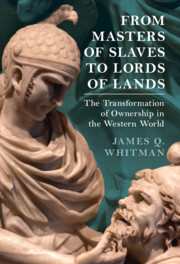Book contents
- From Masters of Slaves to Lords of Lands
- Studies in Legal History
- From Masters of Slaves to Lords of Lands
- Copyright page
- Dedication
- Contents
- Acknowledgments
- Introduction: Owning Humans, Owning Land – Two Primitive Modes of the Property Imagination
- Part I Masters of Men and Beasts
- Part II From Masters to Lords
- 6 Introduction to Part II: From Pierson v. Post to Johnson v. M’Intosh
- 7 From Slavery to Feudalism: The Great Hypothesis
- 8 From Masters to Lords in Late Antiquity
- 9 From the Law of Owning Humans to the Law of Owning Land: The Early Modern Culmination
- Conclusion: From Man the Killer to Man the Tiller
- Bibliography
- Index
- Studies in Legal History
9 - From the Law of Owning Humans to the Law of Owning Land: The Early Modern Culmination
from Part II - From Masters to Lords
Published online by Cambridge University Press: 28 November 2024
- From Masters of Slaves to Lords of Lands
- Studies in Legal History
- From Masters of Slaves to Lords of Lands
- Copyright page
- Dedication
- Contents
- Acknowledgments
- Introduction: Owning Humans, Owning Land – Two Primitive Modes of the Property Imagination
- Part I Masters of Men and Beasts
- Part II From Masters to Lords
- 6 Introduction to Part II: From Pierson v. Post to Johnson v. M’Intosh
- 7 From Slavery to Feudalism: The Great Hypothesis
- 8 From Masters to Lords in Late Antiquity
- 9 From the Law of Owning Humans to the Law of Owning Land: The Early Modern Culmination
- Conclusion: From Man the Killer to Man the Tiller
- Bibliography
- Index
- Studies in Legal History
Summary
This chapter discusses the early modern transformation of the law. By the end of the eighteenth century, the law of ownership was firmly centered on land and the conception of the state was becoming firmly territorial, while the nineteenth century witnessed the abolition of the lawful private ownership of human beings. The chapter traces the rise of an early modern conception of property, which held that acquisition was primarily acquisition of land, and that it was established through cultivation rather than mere occupation. It shows how the venerable law of use rights found a home under a new doctrinal rubric, eminent domain, and discusses the transformation of the ancient law of enslavement through war. The chapter draws on the work of historians of the state who study the rise of a territorial understanding of sovereignty. It emphasizes the long legal history behind the disappearance of lawful private enslavement.
Keywords
- Type
- Chapter
- Information
- From Masters of Slaves to Lords of LandsThe Transformation of Ownership in the Western World, pp. 333 - 384Publisher: Cambridge University PressPrint publication year: 2025

